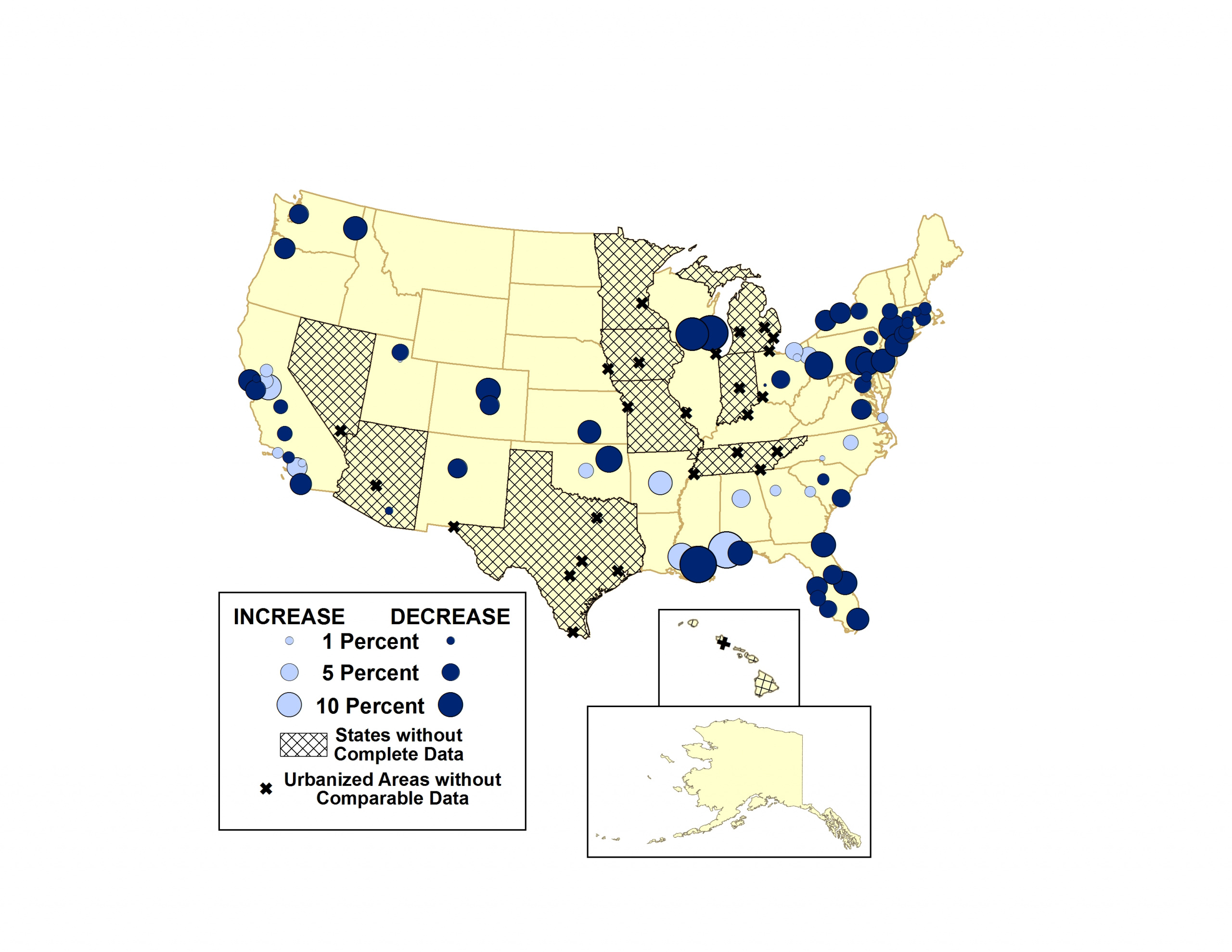Benjamin Davis
Policy Analyst
Policy Analyst
Americans’ transportation habits have changed. The average American drives 7.6 percent fewer miles today than when per-capita driving peaked in 2004.
A review of data from the Federal Highway Administration, Federal Transit Administration and Census Bureau for America’s 100 most populous urbanized areas – which are home to over half of the nation’s population – shows that the decline in per-capita driving has taken place in a wide variety of regions. From 2006 to 2011, the average number of miles driven per resident fell in almost three-quarters of America’s largest urbanized areas for which up-to-date and accurate data are available. Most urbanized areas have also seen increases in public transit use and bicycle commuting and decreases in the share of households owning a car. (See Figure ES-1.)
Regional, state and federal officials need to account for changing trends in driving as they consider how to adapt their transportation policies and infrastructure plans to a new future of slower growth in vehicle travel.
Figure ES-1: Driving Is Declining and Non-Driving Transportation Is Increasing in Urbanized Areas

Transportation trends are changing in America’s biggest urbanized areas.
Figure ES-2: The Proportion of Workers Traveling to Work by Car Has Fallen across the Country (2000 to 2007-2011)

There is additional evidence of declining driving in those urbanized areas with standardized data on vehicle-miles traveled.
Figure ES-3: VMT per Capita Has Declined across the Country (2006 to 2011)

The use of non-driving modes of transportation has increased in a majority of the nation’s most populous urbanized areas.
Variations in the economy do not appear to be responsible for variations in the trends in driving among urbanized areas. In fact, the economies of urbanized areas with large declines in driving have been less affected by the recession according to unemployment and poverty indicators.
The time has come for cities and states to shift their transportation priorities away from investments in expensive, unnecessary new highways, and toward the maintenance and repair of our existing infrastructure and the development of new transportation choices for Americans. To that end, public officials should:
————————————————–
What Are “Urbanized Areas” and Why Are They Important?
An “urbanized area” is a geographic area that is generally larger than a city and smaller than a metropolitan area. The Census Bureau defines urbanized areas as densely developed areas with 50,000 or more residents that include both a central city and adjacent built-up areas (including suburbs). The Census Bureau redefines the boundaries for each urbanized area every 10 years.
Urbanized areas are important geographic units for transportation funding and planning. The 100 largest urbanized areas house more than half of the U.S. population and they are growing rapidly – between 2000 and 2010, the population in all urbanized areas grew 14.3 percent, compared to the total population, which grew 9.7 percent.
Trends in travel in urbanized areas are important both because they are a major indicator of overall vehicle travel and because they have important implications for transportation policy and investment decisions.
————————————————–
* For a list of data sources, see the Methodology. Throughout this report, “2007-2011” refers to data collected by the 2011 American Community Survey 5-year survey which covers years 2007, 2008, 2009, 2010 and 2011. The American Community Survey reports one number for all five years.
** While this report focuses on the transportation trends in America’s 100 most populous urbanized areas, 26 urbanized areas are excluded from the VMT analysis. VMT per capita and changes in VMT over time in these 26 urbanized areas could not be accurately determined due to states’ failure to use standardized and up-to-date data collection methods.
*** While this report focuses on the transportation trends in America’s 100 most populous urbanized areas, two urbanized areas were excluded from the public transit analysis. The passenger-miles traveled on public transit in Mission Viejo (CA) and Ogden-Layton (UT) were excluded because no transit agency lists these two urbanized areas as their primary urbanized area, and the passenger miles and trips traveled within urbanized areas in 2005 were derived from transit agency travel information.
Policy Analyst
